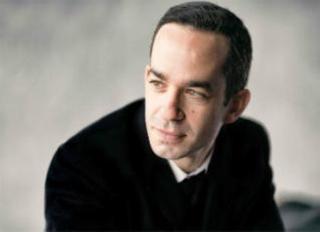|
Back
An Easter Season Resurrection New York
Avery Fisher Hall, Lincoln Center
03/19/2015 - & March 20, 2015
Esa-Pekka Salonen: Nyx
Maurice Ravel: Piano Concerto in G Major
Claude-Achille Debussy: Jeux
Richard Strauss: Suite from Der Rosenkavalier, op. 59 (Revised by Alan Gilbert)
Inon Barnatan (Piano, Artist-in-Association)
New York Philharmonic Orchestra, Alan Gilbert (Music Director/Conductor)

A. Gilbert (© Chris Lee)
Alan Gilbert celebrates the Easter season this week the only way it should be celebrated. By literally resurrecting the dead.
Last week, Thomas Adès conducted the New York Philharmonic in his own Totentanz, the Dance of Death. This week, Maestro Gilbert has rectified that with four–count ’em, four–Dances of Life.
While three of the four were composed within 20 years of each other, they had nought in common. Maurice Ravel’s Piano Concerto was a dance in jazz, specifically Gershwin-style jazz, seen through the eyes of a very refined Frenchman. Claude Debussy’s Jeux, was his only ballet score, and while it was hardly jazzy, one could visualize the sensitive Nijinsky’s feet in each sensuous note.
The opening and closing words were both mythical dances in mythical lands. Richard Strauss’s Rosenkavalier Suite brought to light waltzes in the time of Mozart, 25 years before they became the rage at the Congress of Vienna and composed 95 years after aforesaid Congress. Esa-Pekka Salonen’s Nyx was not supposed to give a literal picture of life and love in ancient Greece, despite the title. But the clarinet solo–played as always with unbelievable grace by Anthony McGill–inevitably was a mirror of Ravel’s ballet Daphnis and Chloé.
Whether Mr. Gilbert programmed the music with these relationships, one cannot know. Yet the result were visions of dancers, real and imagined. And as the varying tempos were paraded, beginning and ending with choruses of French horns, Mr. Gilbert, was literally dancing with the star players of the Phil.
Of course the work by Mr. Salonen, the Phil’s composer-in-residence, was the most intriguing, since, while composed five years ago, it had never been played by the New York Philharmonic. Perhaps Mr. Salonen had composed it with “Sibelius”, the composing app he had developed. But that no more makes a great composer than steroids would make Mr. Salonen a home-run king.
The eponymous heroine is a blurry character from Greek myth, who, with the aid of Chaos and Light, produces Heaven and Earth. Salonen has attempted (amongst other things) to depict the cloudy picture of Nyx through an interesting structure. As he describes it, the themes of horns and clarinets don’t change: the variations come from the orchestra itself.
And what an orchestra! Salonen begins with the chorus of horns (sometimes dissonant, sometimes in hunting guise) goes on with that sensual clarinet solo. And then begins 18 minutes of pulsing and swelling from the orchestra. So varied are the colors, led by a swirling string section, so much rhythmical beating comes from the large percussion section, that the whole aural mural never gets boring. Mr. Salonen can carry us along with the massive sounds, brings us to momentary recognition with those horn/clarinet themes, and then send us off into the orchestral stratosphere.
Yet this is no unceasing soundscape. Several times, the music softens but not into a restful tranquility. Rather, he creates the most vivid colors with combinations of vibraphone, harps, celeste and gongs. I suppose this is “heaven”, but the reality is that Salonen is no Richard Strauss: he isn’t creating any visual picture, but the most intense aural canvas.
The result was most unusual. NY Phil subscription audiences rarely respond to “contemporary’ music with more than perfunctory applause. Here, the composer was called out for three curtain calls, and all well deserved.
The following Ravel had to be compared to the Gershwin Concerto played by Yuja Wang the night before. After all, Gershwin and Ravel had gone together to Harlem in 1928, and this work was written the following year. Indeed, Ravel’s orchestration, especially in the second movement, could never have been duplicated by Gershwin, but both pieces had jazzy, electrifying piano solos.

I. Barnatan (© Courtesy of the Artist)
Here, the piece was played the Phil’s artist-in-residence, Tel Aviv-born Inon Barnatan, who played with all the vigor necessary. And while the jazzy music was a Gallic celebration of la musique hot, the real elegant urbane Ravel came out in the solo of the second movement. Mr. Barnatan played it almost hesitatingly before the lovely wind decorations, giving the illusion that it was created on the spot.
The second half of the program was rare and popular in turn. Rarest of all was Debussy’s Jeux, which Nijinsky envisioned should be a ballet of three men making love together. Debussy was not averse to the story, but a woman took the place of a man, and the site was a tennis court at sundown, flirting kissing and then disappearing into the twilight.
Unlike La Mer, not even an impression of the story is found in the music. Instead, this is a pointillistic work, changing from measure to measure, where one must follow with the greatest concentration. Exactly what Mr. Gilbert did, for even without following the glittering orchestration was gift enough.
The ending Rosenkavalier Suite was not–repeat, not–written by Richard Strauss. It was an arrangement of the opera music, probably by New York Phil conductor Artur Rodziński, and approved by the composer. Here it had a new ending (actually the original opera ending with the candelabra lights snuffed out) by conductor Gilbert.
One imagines that Pierre Boulez, who extols Jeux, would turn up his patrician nose at the joy, the vivacity, the lubriciously hedonist extravagance of the Suite. But, like the other music here, this was the music of life, and it was given an appropriately zingy rendering by Alan Gilbert and his orchestra.
Harry Rolnick
|